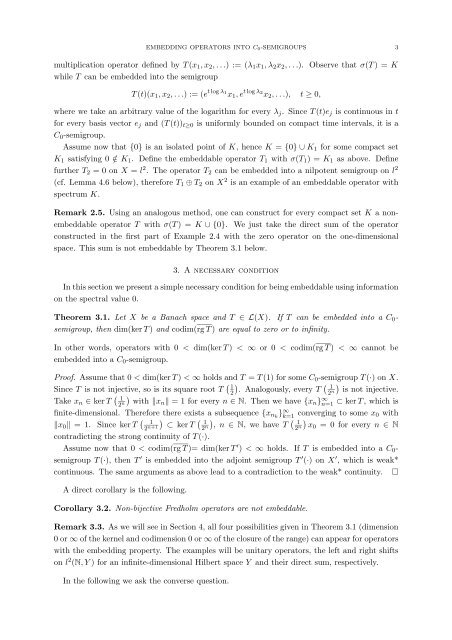EMBEDDING OPERATORS INTO STRONGLY CONTINUOUS ...
EMBEDDING OPERATORS INTO STRONGLY CONTINUOUS ...
EMBEDDING OPERATORS INTO STRONGLY CONTINUOUS ...
Create successful ePaper yourself
Turn your PDF publications into a flip-book with our unique Google optimized e-Paper software.
<strong>EMBEDDING</strong> <strong>OPERATORS</strong> <strong>INTO</strong> C 0 -SEMIGROUPS 3<br />
multiplication operator defined by T(x 1 , x 2 , . . .) := (λ 1 x 1 , λ 2 x 2 , . . .). Observe that σ(T) = K<br />
while T can be embedded into the semigroup<br />
T(t)(x 1 , x 2 , . . .) := (e t log λ 1<br />
x 1 , e t log λ 2<br />
x 2 , . . .), t ≥ 0,<br />
where we take an arbitrary value of the logarithm for every λ j . Since T(t)e j is continuous in t<br />
for every basis vector e j and (T(t)) t≥0 is uniformly bounded on compact time intervals, it is a<br />
C 0 -semigroup.<br />
Assume now that {0} is an isolated point of K, hence K = {0} ∪ K 1 for some compact set<br />
K 1 satisfying 0 /∈ K 1 . Define the embeddable operator T 1 with σ(T 1 ) = K 1 as above. Define<br />
further T 2 = 0 on X = l 2 . The operator T 2 can be embedded into a nilpotent semigroup on l 2<br />
(cf. Lemma 4.6 below), therefore T 1 ⊕ T 2 on X 2 is an example of an embeddable operator with<br />
spectrum K.<br />
Remark 2.5. Using an analogous method, one can construct for every compact set K a nonembeddable<br />
operator T with σ(T) = K ∪ {0}. We just take the direct sum of the operator<br />
constructed in the first part of Example 2.4 with the zero operator on the one-dimensional<br />
space. This sum is not embeddable by Theorem 3.1 below.<br />
3. A necessary condition<br />
In this section we present a simple necessary condition for being embeddable using information<br />
on the spectral value 0.<br />
Theorem 3.1. Let X be a Banach space and T ∈ L(X). If T can be embedded into a C 0 -<br />
semigroup, then dim(kerT) and codim(rg T) are equal to zero or to infinity.<br />
In other words, operators with 0 < dim(kerT) < ∞ or 0 < codim(rg T) < ∞ cannot be<br />
embedded into a C 0 -semigroup.<br />
Proof. Assume that 0 < dim(kerT) < ∞ holds and T = T(1) for some C 0 -semigroup T(·) on X.<br />
Since T is not injective, so is its square root T ( ) (<br />
1<br />
2 . Analogously, every T 1<br />
)<br />
2 is not injective.<br />
n<br />
Take x n ∈ ker T ( )<br />
1<br />
2 with n ‖xn ‖ = 1 for every n ∈ N. Then we have {x n } ∞ n=1 ⊂ kerT, which is<br />
finite-dimensional. Therefore there exists a subsequence {x nk } ∞ k=1 converging to some x 0 with<br />
‖x 0 ‖ = 1. Since kerT ( ) (<br />
1<br />
2 ⊂ ker T 1<br />
) ( n+1 2 , n ∈ N, we have T 1<br />
) n 2 n x0 = 0 for every n ∈ N<br />
contradicting the strong continuity of T(·).<br />
Assume now that 0 < codim(rg T)= dim(kerT ′ ) < ∞ holds. If T is embedded into a C 0 -<br />
semigroup T(·), then T ′ is embedded into the adjoint semigroup T ′ (·) on X ′ , which is weak*<br />
continuous. The same arguments as above lead to a contradiction to the weak* continuity. □<br />
A direct corollary is the following.<br />
Corollary 3.2. Non-bijective Fredholm operators are not embeddable.<br />
Remark 3.3. As we will see in Section 4, all four possibilities given in Theorem 3.1 (dimension<br />
0 or ∞ of the kernel and codimension 0 or ∞ of the closure of the range) can appear for operators<br />
with the embedding property. The examples will be unitary operators, the left and right shifts<br />
on l 2 (N, Y ) for an infinite-dimensional Hilbert space Y and their direct sum, respectively.<br />
In the following we ask the converse question.
















